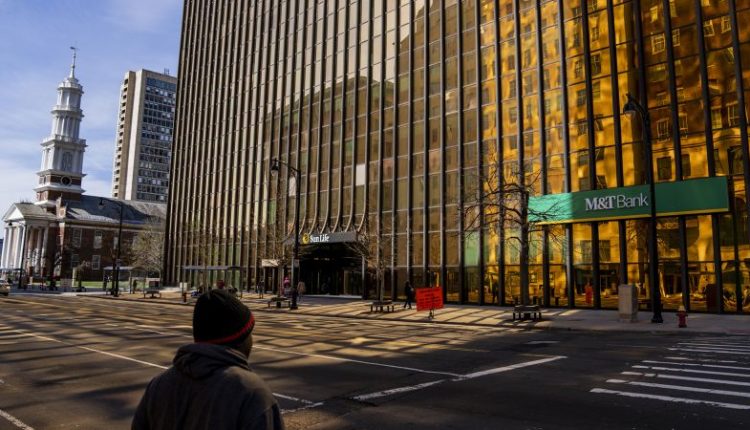Months after the collapse of a handful of regional banks like Signature Bank, First Republic Bank and Silicon Valley Bank, and amid fears of a credit crisis, it looks like the regional banking sector may not be out of the woods quite yet.
Following the bank closings, many other regional banks have had to pay higher interest rates on deposits in order to prevent customers from heading towards the exit. That eats directly into revenue and profitability.
But its hardly the only thing weighing on the sector as companies report Q3 earnings. Higher yields on US Treasuries, the Federal Reserve’s monetary policy campaign and the potential for new capital requirements are top of mind for executives and analysts as the regionals report earnings.
“It’s not built into banks’ strategic plans to lose money,” Nathan Stovall, director of the financial institutions research team for S&P Global Market Intelligence, told CNN. “So they’re going to continue to pay higher rates and one of the issues they’re seeing is if you want to bring in new money, it’s really expensive. They’re also seeing their existing customers shift out of lower-yielding product into higher-yielding product, meaning higher rates.”
That could mean switching from lower-yielding savings accounts to high-yielding certificates of deposit, which many regional banks are actively advertising.
Inside the regional bank earnings reports, three main themes emerged: More money being stashed away to protect against potential consumer or business loan defaults, the continuing growth of interest income and a modest growth in average deposits.
Those posting gains in net interest income (what banks earn on interest minus what they pay out in deposits) as well as gains in credit loss provisions (the money banks set aside for defaults on loans), included US Bancorp, Regions Financial Corp, M&T Bank Corp., PNC Financial Services Group, Inc. and Commerce Bancshares.
Stovall said that one of the main reasons behind the increase in cash set aside is how the credit loss model changed in 2020. The Financial Accounting Standards Board adjusted the Current Expected Credit Losses (CECL) methodology to consider factors like future forecasts, the current economic moment and historical loss information. He said that the increase in reserves isn’t necessarily banks panicking over the future, rather adjusting to a world where interest rates are not historically low.
“Sure, late payments of 30 or even 90 days due have gone up, but off of such historical lows,” Stovall said. “Whether you’re looking at things like consumer trends, auto and especially card — most of the banks and card players are calling it normalization. Basically, a return to long-term trends.”
Four outliers were Keycorp and Huntington Bancshares, both based in Ohio, Comerica in Dallas, and Salt Lake City’s Zions Bancorp. Keycorp saw both net interest income and provisions for credit loss decline. Huntington’s trend of growing net interest income continued but its provisions for credit losses declined by $7 million on a yearly basis.
Comerica saw declines in both provisions and net interest income and a 28% decline in net income compared to last year.
Zions Bancorp had a dramatic decline as well, seeing yearly declines in net interest income and provisions.
Meanwhile, Regions and Comerica went as far as including predictions in their earnings presentations that they expect to see declines in net interest income due to deposit costs and loan selectivity.
Comerica, Huntington, Commerce, Zions, M&T Bank and US Bancorp posted modest gains in deposits for the quarter.
Keycorp, Regions and PNC did not.
PNC’s report, featuring a 4% decline in deposits, came as the bank announced it would be laying off 4% of its workforce as part of cost-cutting measures following smaller net income compared to a year ago. The company fell short of $5.32 billion revenue expectations with $5.2 billion instead, according to Refinitiv.
It still beat on earnings per share with $3.60 versus the $3.11 expected by analysts.
Going forward, if demand for loans dries up, that gets rid of a key source of income for regional banks.
Stovall predicted net interest income can continue to trend upwards on average through the rest of the year with moderation coming in the beginning of 2024, but said that banks are becoming more selective as to who they’re lending to and having to increase interest on those loans in order to make up the money paid out to depositors.
“Deposits are still down year-to-date [and] are shifting what funds they have into loans,” he said. “Demand is going down [due to] how long people will actually be willing to borrow at today’s rates.”
While many of the banks that reported this week were able to beat estimates for revenue and earnings per share, shareholders of these companies have had little to celebrate in the immediate term.
Shares of all companies mentioned above have notched declines since reporting.
The SPDR S&P Regional Banking ETF, a benchmark for judging the performance of shares of regional banks, was down 2.9% over five days as of midday trading on Friday.
Part of that is likely the reaction to the news cycle: 10-year treasury yields topping 5%, fears of escalation in the ongoing war in Gaza and comments by Federal Reserve Chair Jerome Powell which many interpreted as leaving additional action by the Fed to tame inflation on the table.
Meanwhile, the largest US banks, including Citi Group, Wells Fargo and JPMorgan Chase, showed successful third quarter results.
Read the full article here

